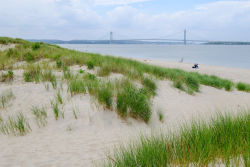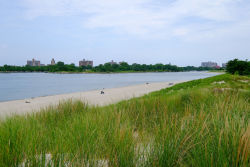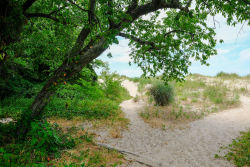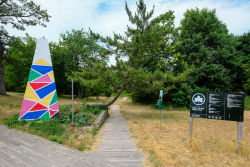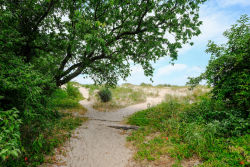Coney Island Creek Park
Coney Island Creek Park
Coney Island Creek is the sole remaining creek in the area. In the 17th and 18th centuries many other creeks cut through Brooklyn, but all others were filled in as Brooklyn developed. The Creek has undergone many topographical and name changes throughout its history.
In the 17th century, the creek did not extend so far eastward, ending instead around what is now Cropsey Avenue. A small portion of land in the now narrow section of the creek connected to the mainland, forming a peninsula. This peninsula was known as Coney Hook. In order to facilitate sea travel, Thomas Stillwell and his associates dug a canal from the eastern front of the creek, around Cropsey Avenue, eastward until they hit “the Cove,” now known as Sheepshead Bay. The developers hoped the canal, referred to as Gravesend Ship Canal, would transform the area into a thriving seaport. The canal was later filled with earth to what is now Shell Road, significantly shortening the creek.
In the early 19th century the creek was known as Gravesend Creek, for it cut through the town of Gravesend, which was incorporated into the city of Brooklyn in 1896. With the consolidation of the City of New York in 1898, Gravesend lost political importance. As Coney Island became an important amusement center in the early 19th century, the creek and the area south of it adopted that name.
Gravesend Bay, into which Coney Island Creek flows, was the site of famed Central and Prospect Park landscape architect, Calvert Vaux’s (1824-1895) death. On a foggy November morning in 1895, while visiting his son who lived nearby, Vaux went for a walk. He never returned, however, and his body was later found floating in the bay. There has never been a definitive cause of death, as some say he committed suicide because his work was under-appreciated and others say the fog and his unfamiliarity with the setting lead him to accidentally fall into the bay.
This park, bounded by Sea Gate and Bayview Avenues and Gravesend Bay, was assigned to Parks in 1984. The area is mostly comprised of many types of grass, shrubs, and trees. A small garden is located in the area with a multitude of flowers and a small stone and brick path. A large sand dune was placed on the property in 2001 in order to stop erosion of the nearby Coney Island Beach, with $1,065,000 in funding from City Council Member Howard L. Lasher.
Check out your park's Vital Signs
Clean & Safe
Green & Resilient
Empowered & Engaged Users
Share your feedback or learn more about how this park is part of a
Vital Park System

